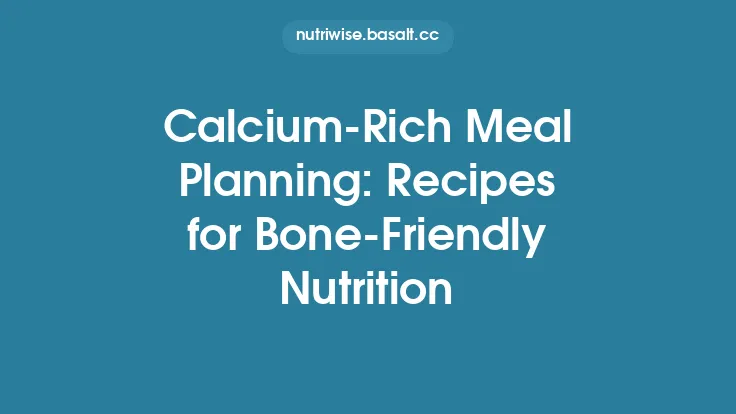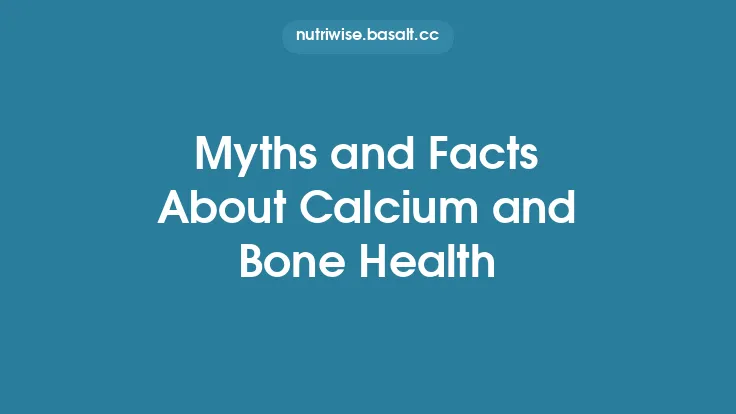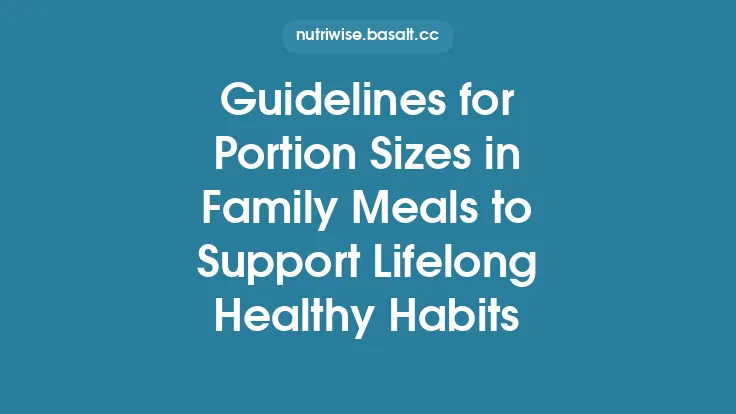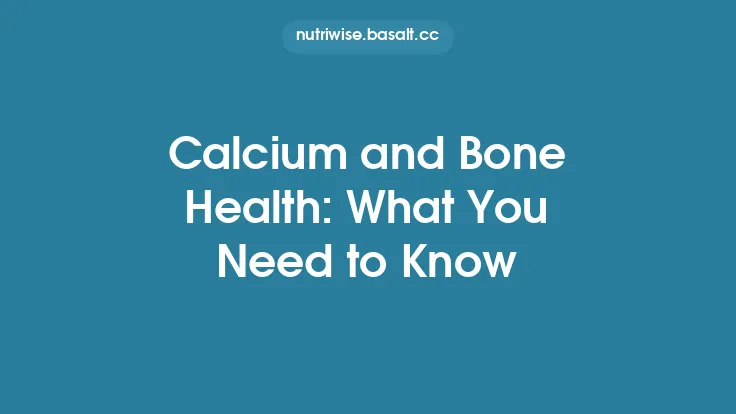Calcium is the most abundant mineral in the human body, and the skeleton serves as its primary reservoir. Throughout life, the skeleton undergoes a dynamic process of formation and resorption that is tightly regulated by hormonal signals, mechanical loading, and nutrient availability. Because the balance between bone deposition and loss shifts dramatically at different ages, the amount of calcium required to support optimal bone health is not static. Understanding how calcium needs evolve—from the rapid growth of infancy to the maintenance phase of later adulthood—allows individuals and health professionals to tailor dietary strategies that promote lifelong skeletal strength while minimizing the risk of osteoporosis and related fractures.
The Biological Rationale for Age‑Specific Calcium Requirements
Bone Modeling vs. Remodeling
- Modeling occurs primarily during childhood and adolescence when new bone is laid down faster than old bone is removed. This phase determines peak bone mass (PBM), a critical determinant of future fracture risk.
- Remodeling is a lifelong process in which old bone is resorbed by osteoclasts and replaced by new bone formed by osteoblasts. With advancing age, the remodeling balance gradually tips toward resorption, especially after the third decade of life.
Hormonal Milestones that Influence Calcium Demand
| Life Stage | Key Hormones | Effect on Calcium Homeostasis |
|---|---|---|
| Infancy (0‑12 mo) | Growth hormone (GH), IGF‑1, high calcitriol | Accelerated bone formation; high intestinal calcium absorption efficiency (~60‑80 %). |
| Childhood (1‑12 yr) | GH, IGF‑1, thyroid hormone | Sustained linear growth; moderate calcium absorption (~40‑60 %). |
| Adolescence (13‑19 yr) | Sex steroids (estrogen, testosterone), GH surge | Pubertal growth spurt; peak bone mass accrual; calcium demand peaks. |
| Early Adulthood (20‑30 yr) | Stable sex steroids, modest calcitriol | Maintenance of PBM; calcium balance achieved. |
| Midlife (31‑50 yr) | Gradual decline in estrogen (women) or testosterone (men) | Slight negative calcium balance begins; bone remodeling rate increases. |
| Late Adulthood (≥51 yr) | Marked estrogen decline (menopause) or testosterone decline (andropause) | Accelerated bone loss; calcium absorption efficiency drops (<30 %). |
| Pregnancy & Lactation | Placental hormones, prolactin, increased calcitriol | Transient calcium mobilization to fetal skeleton and milk production. |
These hormonal shifts dictate not only the absolute calcium intake needed but also the efficiency with which the gut can absorb calcium at each stage.
Recommended Calcium Intakes Across the Lifespan
The following values are based on consensus guidelines from major health agencies (e.g., Institute of Medicine, European Food Safety Authority) and reflect the amount needed to achieve a neutral calcium balance for the majority of healthy individuals in each age bracket.
| Age Group | Recommended Dietary Calcium (RDA/AI) | Rationale |
|---|---|---|
| 0‑6 months (breastfed) | 200 mg/day (AI) | Calcium supplied via breast milk; infant formula fortified to similar levels. |
| 7‑12 months (weaning) | 260 mg/day (AI) | Introduction of complementary foods; modest increase to support rapid growth. |
| 1‑3 years | 700 mg/day (RDA) | High bone formation rate; diet diversification begins. |
| 4‑8 years | 1,000 mg/day (RDA) | Continued linear growth; preparation for pre‑pubertal bone mass accrual. |
| 9‑18 years | 1,300 mg/day (RDA) | Pubertal growth spurt; peak bone mass acquisition. |
| 19‑50 years | 1,000 mg/day (RDA) | Maintenance of PBM; balanced bone remodeling. |
| 51‑70 years (men) | 1,000 mg/day (RDA) | Early post‑menopausal bone loss mitigated by adequate intake. |
| 51‑70 years (women) | 1,200 mg/day (RDA) | Accelerated bone loss after menopause; higher intake needed. |
| >70 years (both sexes) | 1,200 mg/day (RDA) | Declining absorption efficiency; higher intake compensates for reduced bioavailability. |
| Pregnancy (19‑50 yr) | 1,000 mg/day (RDA) + additional 300 mg (AI) | Supports fetal skeletal development; many guidelines incorporate this into the 1,000 mg recommendation. |
| Lactation (up to 6 mo) | 1,000 mg/day (RDA) | Calcium secreted into breast milk (~200 mg/day) is drawn from maternal stores; adequate intake prevents bone loss. |
*Note:* The values above assume a diet providing adequate vitamin D, protein, and other co‑factors essential for calcium utilization. Adjustments may be required for individuals with malabsorption syndromes, chronic kidney disease, or those on medications that affect calcium metabolism (e.g., glucocorticoids, anticonvulsants).
How Calcium Needs Evolve Within Each Life Stage
1. Infancy and Early Childhood (0‑5 years)
- Bone Growth Dynamics: The skeleton doubles its mass in the first year and reaches roughly 25 % of adult bone mass by age five.
- Calcium Sources: Breast milk, fortified infant formula, and later, calcium‑rich complementary foods such as yogurt, soft cheeses, and finely ground nuts.
- Practical Guidance: Because infants have a high intestinal absorption efficiency, modest dietary calcium can meet needs. However, ensuring consistent intake is crucial, as rapid growth leaves little margin for deficiency.
2. Middle Childhood (6‑12 years)
- Bone Accrual: Linear growth continues at a steady pace; trabecular bone volume expands, setting the foundation for later PBM.
- Calcium Demand: The RDA jumps to 1,000 mg/day, reflecting the need to sustain bone matrix deposition while the gut absorption efficiency begins to decline modestly.
- Key Considerations: Encourage calcium‑rich foods at each meal and snack. At this age, children can begin to self‑select foods, making nutrition education essential.
3. Adolescence (13‑19 years)
- Peak Bone Mass Window: Up to 40‑60 % of adult bone mass is accrued during this period, especially in the two years surrounding menarche for girls and the peak of the testosterone surge for boys.
- Highest Calcium Requirement: 1,300 mg/day is recommended to match the rapid osteoblastic activity.
- Gender Differences: Girls often achieve PBM earlier but may experience earlier estrogen‑mediated bone turnover; boys continue accruing bone mass into their early twenties.
- Lifestyle Integration: Physical activity (weight‑bearing sports) synergizes with calcium intake to maximize bone density.
4. Early Adulthood (20‑30 years)
- Stabilization Phase: PBM is typically reached by the late twenties. Bone remodeling becomes the dominant process, with a near‑equilibrium between formation and resorption.
- Calcium Maintenance: The RDA reverts to 1,000 mg/day, sufficient to replace the calcium lost daily through urinary excretion, sweat, and minor gastrointestinal losses.
- Risk Factors: High caffeine intake, excessive sodium, and low protein can subtly increase calcium excretion; awareness helps maintain balance.
5. Midlife (31‑50 years)
- Gradual Bone Loss: Beginning around age 30, a net bone loss of ~0.5‑1 % per year is typical, accelerating in women after menopause.
- Calcium Strategy: Maintaining the 1,000 mg/day intake (or 1,200 mg/day for women approaching menopause) helps offset the early stages of bone loss.
- Adjunctive Measures: While not the focus of this article, adequate protein, regular resistance training, and avoidance of smoking are complementary strategies.
6. Late Adulthood (≥51 years)
- Accelerated Resorption: Post‑menopausal women experience a 2‑3 % annual loss of trabecular bone for the first 5‑7 years; men experience a slower, but still significant, decline.
- Higher Calcium Targets: 1,200 mg/day is advised to compensate for reduced intestinal absorption (down to ~30 %) and increased urinary calcium loss.
- Monitoring: Periodic bone mineral density (BMD) testing can guide whether dietary calcium alone suffices or if pharmacologic interventions are warranted.
7. Pregnancy and Lactation
- Transient Calcium Mobilization: Approximately 30 g of calcium is transferred to the fetus over the course of pregnancy, and about 200 mg/day is secreted into breast milk during lactation.
- Dietary Adjustment: While the baseline adult RDA (1,000 mg) generally covers these needs, many guidelines recommend an additional 300 mg/day during pregnancy and lactation to ensure maternal bone stores are preserved.
- Practical Tips: Incorporate calcium‑dense foods at each meal and consider calcium‑fortified beverages if dietary intake falls short.
Factors That Modulate Individual Calcium Requirements
Even within the same age bracket, several physiological and lifestyle variables can shift the optimal calcium intake upward or downward.
| Modifier | How It Affects Calcium Need | Example Adjustment |
|---|---|---|
| Vitamin D Status | Enhances intestinal calcium absorption; deficiency reduces efficiency to <30 % | Ensure 800‑1,000 IU/day vitamin D; may increase calcium intake by 200‑300 mg if deficient. |
| Renal Function | Impaired kidneys reduce activation of vitamin D and increase calcium excretion | Patients with chronic kidney disease often require individualized medical guidance; dietary calcium may be limited to avoid hyperphosphatemia. |
| High Sodium Intake | Increases urinary calcium loss (≈1 mg per 1 mmol Na⁺) | Reduce sodium to <2,300 mg/day; add ~100 mg calcium for each 1,000 mg excess sodium. |
| Caffeine (>300 mg/day) | Modest increase in calcium excretion (≈6 mg per 100 mg caffeine) | Counterbalance with an extra 100‑150 mg calcium. |
| Physical Activity Level | Weight‑bearing exercise stimulates bone formation, potentially lowering the calcium threshold needed for bone health | Active individuals may maintain bone density with slightly lower intake, but the RDA remains a safe baseline. |
| Ethnicity | African‑American and Asian populations often have higher bone density at lower calcium intakes; Caucasian and Hispanic groups may be more sensitive to low calcium. | No formal adjustment in guidelines, but clinicians may consider cultural dietary patterns when counseling. |
| Medications (e.g., glucocorticoids, proton‑pump inhibitors) | Increase bone resorption or reduce calcium absorption | May require 200‑400 mg additional calcium plus medical management. |
Practical Strategies to Meet Age‑Specific Calcium Targets
- Meal Planning with Built‑In Calcium Buffers
- Infants & Toddlers: Offer fortified cereals, pureed leafy greens, and calcium‑rich yogurts (full‑fat for toddlers).
- School‑Age Children: Include a dairy or fortified alternative at breakfast, a calcium‑rich snack (e.g., cheese sticks), and a calcium‑fortified beverage at lunch.
- Adolescents: Encourage two servings of dairy (milk, cheese, yogurt) or fortified plant milks daily; add calcium‑rich toppings like chia seeds or almonds to smoothies.
- Adults: Aim for three calcium‑containing servings per day; diversify with low‑fat dairy, fortified soy/almond/oat milks, and calcium‑rich vegetables (broccoli, bok choy).
- Older Adults: Prioritize easily digestible sources (e.g., yogurt, soft cheeses) and consider calcium‑fortified foods (orange juice, oatmeal) to meet higher needs without excessive volume.
- Timing and Distribution
- The body absorbs calcium most efficiently when intake is spread across meals (≈300‑500 mg per serving). Large single doses (>1,000 mg) do not increase absorption proportionally and may lead to increased urinary excretion.
- Enhancing Absorption Without Overstepping the Scope
- While detailed absorption mechanisms are beyond this article’s focus, a practical tip is to pair calcium‑rich foods with a modest amount of dietary fat (e.g., cheese with whole‑grain crackers) to aid micelle formation and improve uptake.
- Monitoring Intake
- Use food‑tracking apps or simple logs to ensure daily calcium goals are met, especially during life transitions (e.g., moving from school meals to independent adult eating patterns).
- Addressing Barriers
- Lactose Intolerance: Opt for lactose‑free dairy, fortified plant milks, or aged cheeses (lower lactose).
- Dietary Preferences (e.g., vegan): Emphasize fortified plant milks, calcium‑set tofu, tempeh, and calcium‑rich leafy greens; consider fortified cereals.
- Economic Constraints: Bulk purchase of shelf‑stable fortified milks, canned fish with bones, and seasonal calcium‑rich vegetables.
When to Re‑Evaluate Calcium Needs
- Menopause Transition (≈45‑55 years): A BMD test is advisable; if bone loss is evident, a higher calcium intake (≥1,200 mg) plus lifestyle interventions should be reinforced.
- Post‑Fracture Recovery: After a low‑impact fracture, calcium needs may temporarily increase to support healing; a short‑term boost of 200‑300 mg above the RDA is reasonable.
- Chronic Illness Onset: Conditions such as inflammatory bowel disease, celiac disease, or chronic use of corticosteroids warrant a reassessment of calcium intake, often under medical supervision.
- Advanced Age (>80 years): Even with a high RDA, absorption may be markedly reduced; regular dietary assessment and, when appropriate, medical guidance become essential.
Summary of Key Takeaways
- Calcium needs are dynamic: They rise sharply during infancy, childhood, and adolescence, plateau in early adulthood, and increase again in later life and during pregnancy/lactation.
- Hormonal changes drive demand: Puberty, menopause, and pregnancy each create distinct calcium fluxes that must be matched by dietary intake.
- Absorption efficiency declines with age: Older adults require higher absolute intakes to achieve the same net calcium balance as younger individuals.
- Tailored intake is essential: While the RDA provides a solid baseline, individual factors—vitamin D status, renal health, medication use, and lifestyle—may necessitate adjustments.
- Consistent, distributed intake works best: Aim for 300‑500 mg of calcium per meal, spread across three to four servings daily.
- Regular monitoring ensures adequacy: Use dietary logs, periodic BMD testing, and clinical check‑ins during life transitions to keep calcium intake aligned with skeletal health goals.
By aligning calcium consumption with the physiological demands of each life stage, individuals can build a robust skeletal foundation early, preserve bone mass through midlife, and mitigate the accelerated bone loss that accompanies aging. This age‑specific approach to calcium nutrition is a cornerstone of lifelong bone health, complementing other lifestyle measures such as regular weight‑bearing exercise, adequate protein intake, and avoidance of smoking and excessive alcohol.





